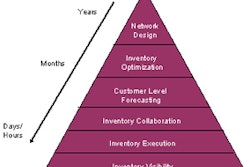Information Consistency is Critical to SCM Success
Pressure to increase profitability through better spend control continues to be at the top of many CEO agendas. Companies composed of business units with separate supply chains and procurement functions often find this challenging — specially if they have a history of mergers and acquisitions or operate on a global basis because there is often no clear picture of spending across these units that can be analyzed.
One of the obstacles for companies in this situation is the lack of a "lingua franca" (common language) for supply chain management (SCM) and procurement. In other words, different parts of the business have different ways of referencing and defining products, vendors, customers and supplies with neither a "master" view of this information for all to share, nor someone who is clearly accountable for information quality.
When Perception is not Reality
This can lead to a wide gap between perception and reality. For example, within a multinational energy company, management reports showed one subsidiary marketing 20,000 products to 20,000 customers, when in reality they were marketing just 5,000 products to 6,000 customers. Imagine how this complicates order entry and fulfillment, as well as budgeting and profitability analysis. Other complications that arise from inconsistent SCM definitions and references often include:
- Different purchasing terms are in place with individual vendors across the business
- Corporate purchasing agreements are not used by all parts of the company
- Reports on corporate spending — by supplier or by material — are composed quarterly or monthly instead of daily
- Analysts spend more time gathering and reconciling data than analyzing it
- Global customers cannot be provided with centralized purchasing from a definitive catalog of products with standard names, packaging and other attributes
- Reports don't reflect market consolidation within the supply chain in a timely way
The consequence of this information inconsistency is millions of dollars lost through a weakened position for supplier and customer negotiations and misinformed spending decisions.
The Early "Solution" — Standardization
So how is this solved? Early attempts revolved around trying to standardize information and definitions across the business and its IT systems (enterprise resource planning, supply chain management and financial applications, primarily). It sounds like an obvious fix; unfortunately for companies that began efforts like this five years ago, they're probably still at it. The time and cost of standardizing data, systems, business processes and employee behavior can run into the hundreds of millions of dollars with project timelines lasting five to 10 years. Yet the larger problem with this approach is business change: The standardization process really never ends as M&A, market consolidation and other events take place.
More Recent Solutions – CDI and PIM
More recently, companies have been gaining control over specific types of information by applying product information management (PIM) and customer data integration (CDI) software. CDI and PIM bring customer and product information together from across disparate sources, make it consistent and then share it back with data entry and reporting applications. These solutions have grown in popularity over the last five years because they address a specific and painful problem.Unfortunately, off-the-shelf software solutions designed for managing vendor, asset, material, chart of account and other information are rare and tend to be custom-built in-house. Another drawback is that these solutions produce silos of customer and product information (albeit useful ones). They don't provide an integrated view of the business, such as what products are distributed by what customers and what customers are also suppliers and what materials they supply, etc. This still leaves room for error and requires much higher IT expense to manage.
Enter MDM – Making Information Quality a Business Process
A newer approach, "master data management" (MDM), is now in vogue within Global 2000 companies. Rather than focus on just customer or product data alone, MDM helps put business people in control of information accuracy for all kinds of data that must be shared across the enterprise. MDM has gained in prominence as companies that recognize information quality is critical to effective business processes also realize that achieving and maintaining information quality should itself be a business process.
Why put business people in charge of master data quality? Because they understand its meaning and use; they just need the right tools to manage it. MDM solutions provide a framework that supports stewardship of data by business people so that information quality can be managed as a business process.
Rather than enforce standardized references and definitions for singular use across the business, the MDM approach starts with a "master view" of the information. This view is generally created and maintained at the corporate level with business people in other functional areas of the company "mapping" their own definitions to it. This means that different units can maintain their own supply chain management software, business definitions and references at the local level, yet a consolidated view across multiple units can be rolled up to the central level. This "local to central" mapping approach eliminates the need for standardization across the enterprise and all the associated costs and delays.
MDM thus creates a true lingua franca for the SCM and procurement functions, providing a common medium for business communication while allowing business units to operate autonomously under their own local market, regulatory and cultural conditions.
Some of the advances that distinguish MDM from earlier solutions such as CDI and PIM include:
- 1. Any master data can be managed, not just customer or product — One large oil company manages over 350 different types of master data with their MDM solution. This provides a higher return on investment than CDI or PIM solutions
- 2. MDM is business-led — Business people collaboratively review, correct, authorize and publish master data. Accountability for information quality clearly lies with business people who have an expert understanding of the data and its meaning
- 3. "Corporate memory" is preserved — Changes to master data are recorded over time so historic views can be recreated to support regulatory or contractual audits and trend analysis, etc.
Getting started with MDM
MDM is a collaborative process between the business and IT, and MDM programs are often co-sponsored by the offices of the chief information officer and the chief financial officer. The MDM strategy, organization and technology vision are established jointly, usually with the input from strategic advisors such as management and IT consultants or enterprise information management and MDM software providers.
MDM systems can be implemented and start providing value relatively quickly by following a "start small, iterate and evolve" approach – often by mastering one type of information such as vendor, then extending it to support product, customer and so on.
Many companies find the quickest way to benefit from their newly mastered data is to use it for management and business intelligence reporting. Within the first several weeks of their MDM implementation, a consumer beverage company discovered distribution reports were omitting data from several metropolitan regions. Correcting the problem quickly eliminated the costs of mis-paid rebates and commissions.
Conclusion
MDM helps supply chain executives address the CEO's demand for better spending control. For many organizations, well-managed master data means companies are now seeing global spending by supplier on a daily basis instead of quarterly, resulting in more effective price negotiation, vendor rationalization and additional spending cost reductions that range in the tens of millions of dollars per year.About the Author: Cliff Longman is the Chief Technology Office at Burlington, Mass-based enterprise software firm Kalido.



















